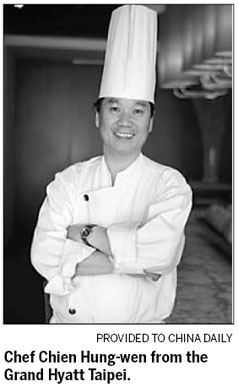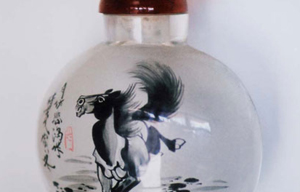Food
Mullet roe, anyone?
Updated: 2011-09-18 07:18
By Ye Jun (China Daily)
|
Pressed salted mullet roe is served with scallions and garlic - a favorite beer food among Taiwanese gourmets. [Pauline D Loh / China Daily] |
Beijing
There is more than just street food in Taiwan, and the island is a paradise for unusual seafood such as rare sturgeons and sea urchin, as Ye Jun discovers.
Forget the usual oyster omelet and three-cups chicken. Forget the street food that Taiwan is famous for. Instead, a Taiwan chef says, Chinese gourmets should experience the rich variety of produce that the island is known for, all year round.
 |
Chef Chien Hung-wen from the Pearl Liang Chinese restaurant of the Grand Hyatt Taipei wants to showcase Taiwan's specialties.
"Taiwan has been called a 'treasure island'. It has clearly defined seasons through the year, and abundant produce in each," says the 54-year-old chef who was in Beijing to host a Taiwan gourmet event in August.
Because of its long shoreline, Taiwan values abalone, sea cucumber, fish maw and sharks fin - just like the Chinese mainland. But the island also has some unique seafood.
"In the Taiwan Strait, there is a special species of sturgeon. Beyond Taiwan, it is only available in Japan and the Philippines," Chien explains. "The belly of the fish is so delicious you can get addicted with just one bite."
The sturgeon is a big fish that can measure up to five or six meters and one fish can cost from 700,000 to 800,000 yuan ($109,700 to $125,000), according to the chef.
Taiwan also produces other seafood, such as sea urchin. Another specialty is mullet roe, which is salted, pressed and sun-dried. It is very flavorful, and is usually served with garlic and scallions to offset its richness. A hundred grams costs around 100 yuan ($16).
On land, Chien says, Taiwan has more than 10 varieties of bamboo shoots, and many vegetables and fruits, including the loofah or silk gourd, pumpkin, bitter melon, pineapple, banana, pomelo, papaya, mango, lychee and longan.
Apart from the rich cornucopia of ingredients, Taiwan cuisine is also blessed with a wide spectrum of regional cuisines to draw from.
"When the Kuomintang moved to Taiwan in 1949, Chiang Kai-shek brought along many chefs from the Chinese mainland. My generation was the first to learn from these old-timers," Chien says. He has been cooking for more than 40 years, after starting in the kitchens when he was only 12.
Chien learned what he calls "outer province" cuisines - cooking styles from Shanghai and Sichuan.
"A good chef should go anywhere, and then be able to cook the food there," he says.
 |
He says Taiwan chefs have modified mainland cuisines, tempering them to local tastes and softening the strong and spicy flavors, making them "lighter and clearer, more like Jiangsu and Zhejiang food".
Taiwan is also greatly influenced by Japanese cooking and has adopted sushi, sashimi and seaweed into its cuisine.
Chien describes modern Taiwan as "a melting pot", where one can see cooking styles from all over China, including Sichuan, Hunan, Hubei, Xinjiang, Beijing and Nanjing. There are also Fujian and Hakka influences, where many Taiwan people come from, and that is reflected in the salted fish and pickled vegetables seen in the island's cooking.
You can contact the writer at yejun@chinadaily.com.cn.
E-paper

The snuff of dreams
Chinese collectors have discovered the value of beautiful bottles
Perils in relying on building boom
Fast forward to digital age
Bonds that tie China. UK
Specials

Let them eat cake
Cambridge University graduate develops thriving business selling cupcakes

A case is laid to rest
In 1937, a young woman'S body was found in beijing. paul french went searching for her killer

Banking on change
Leading economist says china must transform its growth model soon

